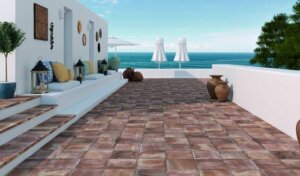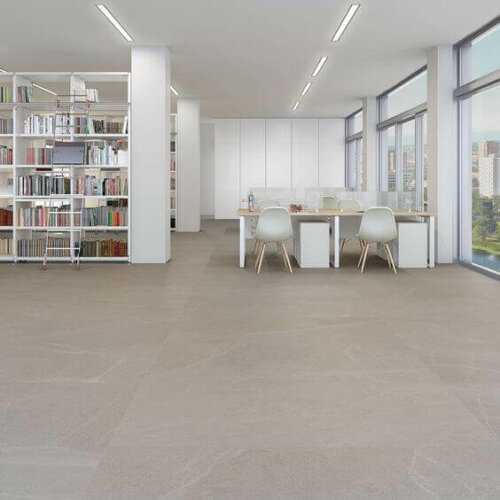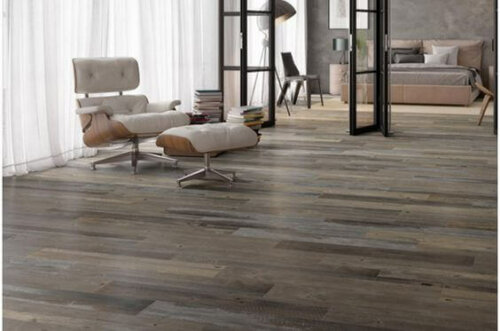Glazed Porcelain Stoneware - the Main Features

The materials that we usually use for interiors are most commonly stone, wood, metal, glass, leather, plastic, and ceramic. Within this last group, we want to highlight glazed porcelain stoneware.
If you’re interested in a new aesthetic in your home, you need to think about some different options for both the inside and outside of the house.
The diversity of resources available today allows you to choose the best option. In other words, you can see what’s out there and choose ideas that allow you to use a new decorative approach.
What is glazed porcelain stoneware?

This material is a great option for high traffic areas. It is very durable over time and can look like new for many years. It’s a very strong resource.
It’s made up of a compact paste organized as tiles so it’s useful for both floors and walls. You usually don’t see any wear and tear on the surface and it’s also suitable for exteriors.
Also, it’s very different from other types of ceramic due to its lower water absorption capacity so you can use it for wet areas and even for swimming pools. It also has a texture that prevents any possible slipping, providing safety and comfort.
A material that, in addition to being elegant, offers functionality.
Glazed porcelain stoneware – 5 features

What do we usually look for in flooring? Mainly that it’s comfortable and that it lasts over time. When it’s low quality, you’ll need to update it in a very short time. However, this isn’t the case with glazed porcelain stoneware. Let’s take a look at some of its basic qualities:
- This material is made up of sandy clay that’s baked in an oven at a temperature of 2,200 degrees Fahrenheit. It’s perfectly vitrified without becoming porous in texture. People call this process glass sintering.
- This is a product that’s suitable for different spaces in the house. It doesn’t matter if you get this material wet either since one of the best features of porcelain stoneware is that it’s impermeable and hardly absorbs any water.
- One of the biggest problems with these floors is that with continuous use, there can be some abrasion. However, this material doesn’t get damaged much from daily wear and tear and can maintain a perfect surface for a long time.
- The sheen of this floor adds to internal luminosity, giving it the name “enameled.” Therefore, it looks stylish and adds an elegant touch to the room.
- Another quality of this material is how smooth it is. Your feet are sure to feel comfortable as you walk around on these tiles.
Types and aesthetic perception

There’s a very wide variety of different shades that offer different aesthetics or create visual effects. One of the most popular is one that imitates cement. In this case, gray is the predominant color that can look great in certain rooms.
On the other hand, we should mention there are some very interesting options that look like marble, wood, or stone. The resemblance is so similar that sometimes it seems like you’re looking at the authentic material.
You also remember one of the most common styles, which people use for swimming pools, terraces, and garden areas – stoneware with the appearance of baked clay. This style reflects warmth and a somewhat rougher texture, but without losing its natural qualities.
Cleaning glazed porcelain stoneware
One of the great things about this type of floor is the easy cleaning process. You can use different products, such as bleach or ammonia without worrying about damaging the material. The color also won’t fade and the ceramic will not lose any of its resistance.
Stains also don’t easily mark the material and you can use water without worrying. It won’t damage the surface and the stoneware will dry quickly and easily. Therefore, if you’re considering this material, you can see that it has some clear advantages.
The materials that we usually use for interiors are most commonly stone, wood, metal, glass, leather, plastic, and ceramic. Within this last group, we want to highlight glazed porcelain stoneware.
If you’re interested in a new aesthetic in your home, you need to think about some different options for both the inside and outside of the house.
The diversity of resources available today allows you to choose the best option. In other words, you can see what’s out there and choose ideas that allow you to use a new decorative approach.
What is glazed porcelain stoneware?

This material is a great option for high traffic areas. It is very durable over time and can look like new for many years. It’s a very strong resource.
It’s made up of a compact paste organized as tiles so it’s useful for both floors and walls. You usually don’t see any wear and tear on the surface and it’s also suitable for exteriors.
Also, it’s very different from other types of ceramic due to its lower water absorption capacity so you can use it for wet areas and even for swimming pools. It also has a texture that prevents any possible slipping, providing safety and comfort.
A material that, in addition to being elegant, offers functionality.
Glazed porcelain stoneware – 5 features

What do we usually look for in flooring? Mainly that it’s comfortable and that it lasts over time. When it’s low quality, you’ll need to update it in a very short time. However, this isn’t the case with glazed porcelain stoneware. Let’s take a look at some of its basic qualities:
- This material is made up of sandy clay that’s baked in an oven at a temperature of 2,200 degrees Fahrenheit. It’s perfectly vitrified without becoming porous in texture. People call this process glass sintering.
- This is a product that’s suitable for different spaces in the house. It doesn’t matter if you get this material wet either since one of the best features of porcelain stoneware is that it’s impermeable and hardly absorbs any water.
- One of the biggest problems with these floors is that with continuous use, there can be some abrasion. However, this material doesn’t get damaged much from daily wear and tear and can maintain a perfect surface for a long time.
- The sheen of this floor adds to internal luminosity, giving it the name “enameled.” Therefore, it looks stylish and adds an elegant touch to the room.
- Another quality of this material is how smooth it is. Your feet are sure to feel comfortable as you walk around on these tiles.
Types and aesthetic perception

There’s a very wide variety of different shades that offer different aesthetics or create visual effects. One of the most popular is one that imitates cement. In this case, gray is the predominant color that can look great in certain rooms.
On the other hand, we should mention there are some very interesting options that look like marble, wood, or stone. The resemblance is so similar that sometimes it seems like you’re looking at the authentic material.
You also remember one of the most common styles, which people use for swimming pools, terraces, and garden areas – stoneware with the appearance of baked clay. This style reflects warmth and a somewhat rougher texture, but without losing its natural qualities.
Cleaning glazed porcelain stoneware
One of the great things about this type of floor is the easy cleaning process. You can use different products, such as bleach or ammonia without worrying about damaging the material. The color also won’t fade and the ceramic will not lose any of its resistance.
Stains also don’t easily mark the material and you can use water without worrying. It won’t damage the surface and the stoneware will dry quickly and easily. Therefore, if you’re considering this material, you can see that it has some clear advantages.
All cited sources were thoroughly reviewed by our team to ensure their quality, reliability, currency, and validity. The bibliography of this article was considered reliable and of academic or scientific accuracy.
AA. VV.: Pavimentos. Nuevos revestimientos, Barcelona, UPC, 2002.







